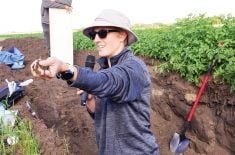CANORA, Sask. – Preliminary data from research at Saskatchewan sites shows no significant yield effect from using fungicides on oats.
Agronomist Bill May said other factors are more important than fungicide treatments.
His research is looking at when fungicide application provides an economic benefit to control crown rust. There is also a general belief among growers that fungicide improves yields even when rust isn’t a concern.
The plots contain several cultivars with different resistance levels to rust, both untreated and treated with Headline.
Read Also

Soybean market still figuring out implications of China-U.S. pact
Soybean futures had a muted reaction to the U.S. trade deal with China as the market tries to figure out the nuances of the deal.
The cultivars included Leggett, Boyer, Orrin and Morgan.
May told producers at the East Central Research Foundation field day July 22 that the 2009 data showed only a six bushel advantage to using Headline when including data from the Manitoba oat rust nursery in the trials and no benefit when the nursery data was removed.
“Once we have the second year data, we can make more definite conclusions.”
Seeding date, rate and cultivar selection will have a bigger impact on yield than fungicide applications, he said.
For example, seeding in mid-May versus seeding in early June led to a 20 to 25 bu. yield advantage in the same plots.
At the Canora site, there will be no seeding date data this year because it was too wet to plant the later crop.
May said seeding rate is a factor in yield response when wild oat pressure exists. Growers should aim for 300 plants per sq. metre and 375 plants per sq. metre when wild oats are a concern.
That equates to seeding rates of 2.4 to 4 or 4.5 bu. per acre, he said. He recommended a maximum 55 pounds of nitrogen and added he would not use seed treatments.
“There are a lot of agronomic issues you should address before fungicides.”
May also said he worries about using fungicides as prophylactics because that could lead to resistance. Rust hasn’t been a huge concern the last few years, especially in Saskatchewan.
“We should use (fungicide) when we have a reason to use it,” he said.
The milling industry would prefer growers not use fungicide, he added.
Oat management
Weed Control
Weeds reduce yield and quality. Weed seeds that may cause the crop to be downgraded include other cereal crops, grains other than cereal crops and wild oats. No herbicides are available for controlling these weeds in oats. Use proper crop rotations and control strategies.
Insects
Aphids, armyworms, cutworms, leafhoppers, grass thrips, wireworm, grasshoppers and the wheat stem maggot can damage oats.
Diseases affecting oats
Earlier seeding and heavier seed rates will reduce damage by barley yellow dwarf virus. The primary symptom of infection in oats is red leaf.
Seed treatments are available to control seedling blight and smut diseases carried on the seed. Most older varieties have only poor resistance to crown rust (leaf rust) and serious yield losses can occur especially to late seeded oats. Oat varieties resistant to stem rust are available.
Swathing
The best yields are obtained by swathing at 35 percent kernel moisture. The greenest kernels at this stage have just changed from green to cream. For the highest milling grades, the sample should not include green hulls.
Combining
Dehulled kernels must be avoided to achieve the highest grades. This may require slower cylinder speed and wider concave clearances. Hulless oats are vulnerable.
Source: Manitoba Agriculture















